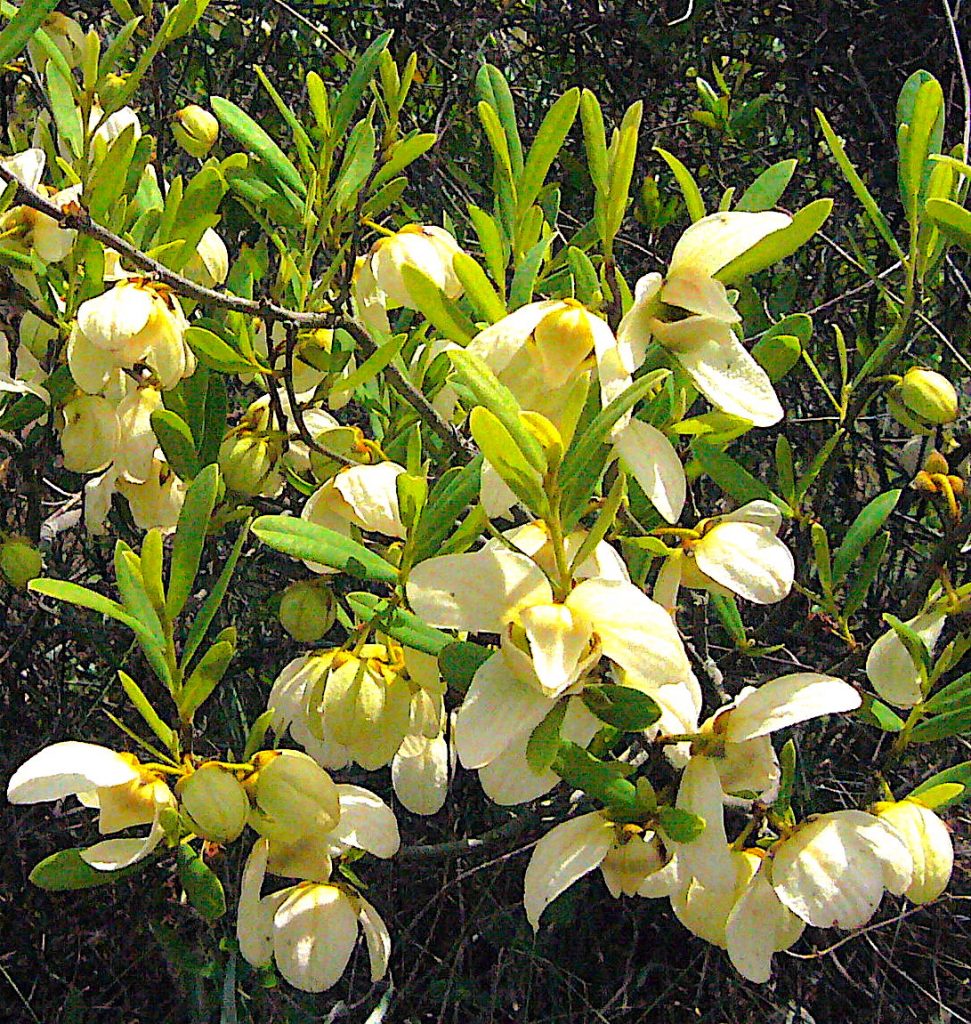
Pawpaws are blossoming heavily. Photo by Green Deane
I don’t play Flag Football. In fact I don’t think I have ever played any sport. But this time of year I do play Flag Pawpaw, Asimina obovata. How do I play? Driving down the road at 60 miles per hour…Okay, maybe not that fast. But, with care, I look for shrubs in pastures, shrubs one to six feet high with large, almost Magnoila-like blossoms. Those will be Pawpaws and now is the easiest time to find them. They won’t fruit for a couple of months but at least you’ll know where they are. And yes, Pawpaw were mentioned in a recent newsletter but the topic is worth revisiting because they are very easy to find now. Look for them.
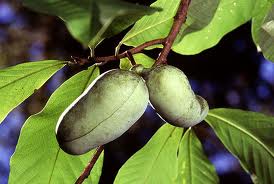
Pawpaws seeds are not edible.
Grazing livestock tend to leave Pawpaws alone. It could be because the blossoms smell like rotting meat. That attracts a carrion fly which thinks there’s rotting flesh nearby but ends up pollenating the Pawpaw (that almost sounds like a poem or a country song.) I would also think the shrub and leaves also aren’t tasty or they would be eaten as well. But, that makes Pawpaw easy to spot. Often they are the only shrub in a pasture, their unpalatability increasing survivability. As humans we like Pawpaws and there are commercial varieties. But they also cause one in a million anaphylactic shock. So don’t eat your first Pawpaw by yourself. That liability keeps lawyers keeping Pawpaws off the market in the United States, or other places where product law suits are common. You can read about Pawpaws here.
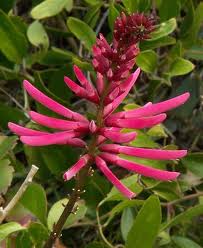
Humming birds like the Eastern Coral Bean. Photo by Green Deane
Also easy to spot this time of year is the Eastern Coral Bean aka Cherokee Bean. It’s a skinny spike with long, tubular flowers, usually in dry places. During our foraging class at Haulover Canal this week they were in full bloom everywhere. While a few of the blossoms are edible raw, they are usually boiled then mixed with scrambled eggs. That’s been mom’s home cooking for many centuries from Southwestern United States into Mexico. Why that combination and why it is a tradition I do not know. Traditions often just happen. But I do know that when you boil the blossoms for a few minutes they turn green. Funny how foraging books in the past never mentioned that. Maybe the writers didn’t actually eat the blossoms. The flowers don’t have a particular flavor raw or cooked. In time the blossoms turn into large red beans with black tips. The beans are toxic. Don’t eat them. The young leaves, actually leaflets of three, are also edible cooked but little to write about. To read more about the Eastern Coral Bean go here.
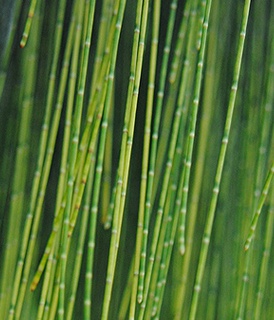
The rings are the function of leaves on the Australian Pine.
Is it time to mention the Australian Pine again, which really isn’t a pine. Indeed there are many plants called “Pine” that are not pines… the Australian Pine, the Norfolk Pine, the Screw Pine. As they are not in the Pinus genus they usually are not used like true pines. As for the Australian Pine it is more closely related to the oaks but does have some edible parts, barely. You can drink the red sap. The dry sap also turns into a gum that is edible. Young cones, seeds and branchlets are also edible cooked but you have to be really hungry. The tree is also an indicator of fresh water, even on the shore. Where they grow there will be fresh water, either floating on top of salt water or in a swale. And, you can dig up the shallow roots for water. The tree has been in this part of the world for about 170 years. As with many invasive species the U.S. Department of Agriculture had a hand in their proliferation. Locally it was in Palm Beach by 1921 and within 20 years it was the most planted tree in Florida. Within 10 years after that ordinances were being passed to control it. You can read about the invasive species here.

Foraging classes are held rain or shine also cold or accompanied by piglets. Photo by Green Deane
Foraging Classes: This past week we wandered around Haulover Canal, north of the space center. It’s the longest class walk — four miles — and can be hot and dusty. It usually includes some climbing and scrambling along a skinny walkway under both sides of the bridge. We saw what one would expect to see in Oak Scrub except cool temperatures are moderated by the water there. One very odd-man out was Lambsquarters on the shore of Mosquito Lagoon. It’s usually found in rich agricultural soil but there it was. We also got to taste two common shore edibles, Sea Blite and Beach Carpet. Edible, but not so easy to catch, were three young wild pigs. The upcoming classes are:
Saturday, March 24th, Florida State College, south campus, 11901 Beach Blvd., Jacksonville, 32246. 9 a.m. We will meet at building “D” next to the administration parking lot.
Sunday, March 25st, Boulware Springs Park, 3420 SE 15th St., Gainesville, FL 32641. Meet at the picnic tables next to the pump house, 9 a.m.
Saturday, March 31st, Wickham Park, 2500 Parkway Drive, Melbourne, FL 32935-2335. Meet at the “dog park” inside the park, 9 a.m.
Saturday April 7th, Colby-Alderman Park: 1099 Massachusetts Street, Cassadaga. Fla. 9 a.m., meet near the restrooms.
Sunday April 8th, Eagle Park Lake, 1800 Keene Road, Largo, FL 33771. 9 a.m. Meet at the pavilion near the dog park
Saturday, April 14th, Blanchard Park, 10501 Jay Blanchard Trail, Orlando, FL 32817. 9 a.m. Meet at the pavilion east of the tennis courts near the YMCA.
Sunday, April 15th, Red Bug Slough Preserve, 5200 Beneva Road, Sarasota, FL, 34233, 9 a.m.
Saturday, April 22nd, Spruce Creek, 6250 Ridgewood Ave. Port Orange, 32127, 9 a.m., meet at the pavilion.
To read more about the classes or to pre-pay go here.
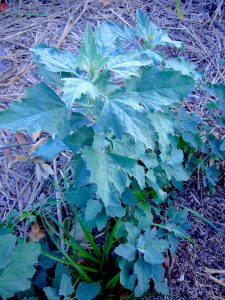
Lambsquarters often has a mealy look. Photo by Green Deane
Lambsquarters was one of the first edible wild plants I learned about because they grew with wild mustard in our front lawn (which as one might guess was not really a lawn.) Other edibles around the house were wild raspberries, apples, grapes, choke cherries, strawberries, blueberries, dandelions, sand roses and violets near the septic tank. They were called “Johnny Jump UPs” and my mother loved them. As one might guess Lambsquarters (aka Pigweed and Fat Hen) was a common weed in rural Maine where I grew up. Besides our front lawn we had two neighbors who always had a huge unintentional stand of them. Here in Florida they are harder to find. I’ve had the most success in abandoned or poorly kept citrus groves. Indeed, one place where I used to harvest them regularly was just such an ignored grove. Now it’s a residential community and no Lambsquarters. So as mentioned above it was not only an uncommon find this past weekend but in a very unusual place, not ten feet from the brackish water of Mosquito Lagoon. You can read about the weed here.
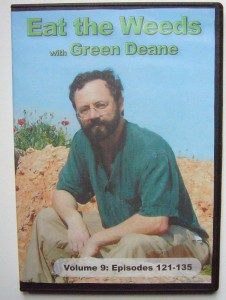
The DVD set has 135 videos.
All of Green Deane’s videos available for free on You Tube. They do have ads on them so every time you watch a Green Deane video I get a quarter of one cent. Four views, one cent. Not exactly a large money-maker but it helps pays for this newsletter. If you want to see the videos without ads and some in slightly better quality you can order the DVD set. It is nine DVDs with 15 videos on each for a total of 135 videos. Many people want their own copy of the videos or they have a slow service and its easier to order then to watch them on-line. The DVDs make a good gift for that forager you know especially on long, cold winter months. Individual DVDs can also be ordered or you can pick and choose. You can order them by clicking on the button on the top right hand side of this page (if your window is open wide enough.) Or you can go here
 Donations to upgrade EatTheWeeds.com and fund a book are going well and is approaching the half way mark. Thank you to all who have contributed to either via the Go Fund Me link, the PayPal donation link or by writing to Green Deane POB 941793 Maitland FL, 32794. Recent upgrades have been paid now the Forum needs work and several function problems need to be fixed specifically the search and categories. A new server also has to be found by April. The other issue is finding an indexing program or function for a real book. Writing programs used to do it automatically if you designated a term for indexing. Now that most books are ebooks most writing programs do not provide and indexing function. The hunt continues.
Donations to upgrade EatTheWeeds.com and fund a book are going well and is approaching the half way mark. Thank you to all who have contributed to either via the Go Fund Me link, the PayPal donation link or by writing to Green Deane POB 941793 Maitland FL, 32794. Recent upgrades have been paid now the Forum needs work and several function problems need to be fixed specifically the search and categories. A new server also has to be found by April. The other issue is finding an indexing program or function for a real book. Writing programs used to do it automatically if you designated a term for indexing. Now that most books are ebooks most writing programs do not provide and indexing function. The hunt continues.

Green Deane Forum
Want to identify a plant? Looking for a foraging reference? Do you have a UFO, an Unidentified Flowering Object you want identified? On the Green Deane Forum we chat about foraging all year. And it’s not just about warm-weather plants or just North American flora. Many nations around the world share common weeds so there’s a lot to talk about. There’s also more than weeds. The reference section has information for foraging around the world. There are also articles on food preservation, and forgotten skills from making bows to fermenting food. One special section is “From the Frightening Mail Bag” where we learn from people who eat first then ask questions later. Recent topics include: Bacopa monnieri, Herbalist Question, Bittercress?, Pine Pollen, Pawpaw? Thistle Flower Buds, Gigantic Pony Foot, Beach Carpet? Lots of Smilax and early Grapes Showing UP, Some Kind Of Pennywort, Plants Called Bugle, and Partridgeberry. You can join the forum by clicking on “forum” in the menu.
As many who attend foraging classes have learned almost all seaweed is edible. But most of it does not taste good. Today let’s look a related topic: Is there arsenic in seaweed?
The answer is yes and no (and know Loquat fruit also have a bit of arsenic.) The debate has a couple of salient points: First is the arsenic natural or man-made? Natural (organic arsenic) usually comes from the digestion of arsenosugars (not unlike cyanide from the digestion of glyco-cyanides in non-agricultural cassava.) Upon digestion the arsenic is released. Then, secondly, there is the separate issue of contamination by man-generated inorganic arsenic which is also in a different chemical form.
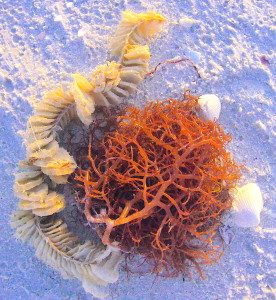
Empty skate eggs and red Gracilaria. Photo by Green Deane
Two times in the last 12 years Canadian and British governments warned consumers to limit consumption of the seaweed Hijiki (Hizikia fusiformis) because of high levels of inorganic arsenic. It was not banned because there was little data on consumption of Hijiki and possible illness from arsenic compounds. The advice was to limit to consumption of that seaweed. The greatest threat from Hijiki appears to be an increase in liver cancer. Other commercial seaweeds were not included in the warning such as Arame, Nori, Kombu, and Wakame. They were found to be free of arsenic. A study last year found that brown seaweed has higher inorganic arsenic concentrations than red seaweed. Those would be Hijiki, Kombu, Wakame, Arame; red varieties were Nori and red seaweed. Agar and kelp noodles were relatively low in arsenic concentrations. Wakeme seemed to be the lowest among the brown ones. And actually in all samples the concentrations were “negibible” except Hijiki. A 2015 study again found Hijiki to be of the most concern. The Japanese government says they have no cases where consumption of Hijiki has lead to any know cases of illness related to organic arsenic. Hijiki is usually harvested off the shores of Japan and Korea. Hijiki had not only high organic forms of arsenic but also inorganic forms as well. Perhaps the plant has an affinity for arsenic no matter what its form. The metal is present in seawater naturally and by pollution. Again, other seaweeds tested had no detectable levels of inorganic arsenic. In most seaweed products the amount of inorganic arsenic is less than one part per million.
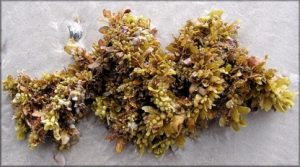
Sargassum: Edible but not the best of tastes. Photo by Green Deane
Separate from that a March 2016 report in the Caribbean says Sargassum has a high capacity for accumulating heavy metals such as arsenic and cadmium. The French Agency for Food, Environmental and Occupation Health and Safety, ANSES, recommended “prohibiting any possible food or feed uses of this seaweed until more in-depth studies can be conducted on the heavy metal contamination of seaweed.” Yet another 2016 report did not mention specific “marine pollutants.” It said among the Sargassums S. fluitains has the lowest amounts of organic arsenic. Sargassum has been used for both fertilizer and animal feed. It is 3 to 16% protein, average 12.8%. Lipid content is mostly PUFAs. It contains a long list of chemicals from polysaccharide to flavonoids and is 3 to 16% protein, average 12.8%. Lipid content is mostly PUFAs. Interestingly Sargassum only begins to decompose when it is on the beach.
Other than Hijiki seaweed seems a good food in its natural state and is not an arsenic concern, at least naturally. The real issue — as it is with most foraging — is how contaminated is the water. Here are some of my articles on seaweeds: Bladderwrack, Caulpera, Codium, Gracilaria, Sargassum, Sea Lettuce, and Tape Seagrass.
This is weekly issue 295.
If you would like to donate to Eat The Weeds please click here.


Thanks for the reminder regarding lambsquarter! Went out in my back yard and sure enough, they are coming up. I have several large pots that had sat idle for a couple of years, but now sport a good container crop of C. album. Luckily this is within my garden fence so my stepson’s four dogs can’t pee on them. Since they moved in with us over three years ago (grrr…), the only ‘safe’ places to forage in my yard are within my garden fence (between the raised beds), and within the fence surrounding my beehives (to keep dogs and grandchildren from disturbing the bees of course).
I very much enjoy reading Eattheweeds ; besides the useful knowledge I gain , the style followed in introduing the articels is attracting and keeps one to contiue till end . As an example I’ve gone through the articel “Pigweed Porpurrie ” where I almost lived the company of the great strong good ideal neighbour Mr. Bill Gowan . Thanks for the good effort you keep providing to all inside and outside Florida . I hope l can e- mail some images for identifying ;the weed which I think bears some similarity with chamopodiums .